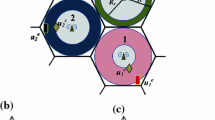Abstract
The focus in Mobile communication networks has been addressed to high data rate networks that offer high quality of service. Long Term Evolution Advanced (LTE-A) technology has been the first to completely fulfill 4G requirements. However, performance gains remain limited due to severe interference levels. For this reason, the Inter-Cell Interference (ICI) problem is one of the main challenges in LTE-A systems. In order to deal with this ICI problem, in this paper we propose a novel framework to analyze the fairness of several scheduling techniques when Fractional Frequency Reuse (FFR) schemes are used. We evaluate the system performance of a typical FFR-based LTE-A scenario. Performance results show the optimum values of the Signal to Interference plus Noise Ratio and partition bandwidth for frequency reuse that maximizes the spectral efficiency. Fairness evaluation has been done in terms of the Gini index, showing a trade-off between spectral efficiency and fairness among users. In that sense, the proposed Truncated-Equal Transmission Rate scheduling policy is able to adjust this trade-off by means of a parameter \(\varepsilon\).





Similar content being viewed by others
Notes
It would be also possible that each cell transmits in the whole frequency band adjusting the power allocation, \(P_t\), of each sub-band in order to minimize the interference [2], but this issue is out of the scope of this work.
References
Hamza, A.-B., et al. (2011). Inter-cell interference coordination. In 4G++ Project: Advanced performance boosting techniques in 4th generation wireless systems, Deliverable D4.1.
Bilio, D., Bouras, C., Kokkinos, V., Papazois, A., & Tseliou, G. (2012). Optimization of fractional frequency reuse in long term evolution networks. In Proceedings of IEEE wireless communications and networking conference (pp. 1853–1857).
Necker, M. C. (2007). Coordinated fractional frequency reuse. In Proceedings of ACM symposium on modelling, analysis, and simulation of wireless and mobile systems (pp. 296–305).
Ali, S. H., & Leung, V. C. M. (2009). Dynamic frequency allocation in fractional frequency reused OFDMA networks. IEEE Transactions on Wireless Communications, 8(8), 4286–4295.
Barnett, N. S., & Dragomir, S. S. (2008). Advances in inequalities from probability theory and statistics. New York: Nova Science Publishers.
Shi, H., Seghu, H., & Kanhere, S. S. (2005). An evaluation of fair packet schedulers using a novel measure of instantaneous fairness. Compute Communications, 28, 1925–1937.
Acknowledgements
This work has been partially supported by the Spanish Government under the Project TEC2013-44442-P.
Author information
Authors and Affiliations
Corresponding author
Rights and permissions
About this article
Cite this article
Delgado-Luque, I.M., Aguayo-Torres, M.C., Gómez, G. et al. A Framework to Evaluate Fairness in Fractional Frequency Reuse Based Cellular Networks. Wireless Pers Commun 95, 287–297 (2017). https://doi.org/10.1007/s11277-016-3892-6
Published:
Issue Date:
DOI: https://doi.org/10.1007/s11277-016-3892-6




